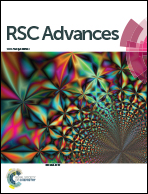Pressure induced semiconductor–metal phase transition in GaAs: experimental and theoretical approaches†
Abstract
Gallium arsenide (GaAs) exhibits outstanding electron transport properties that are useful for many electronics industries. High pressure is a powerful way to induce dramatic electrical conductivity changes in materials. Herein, we investigated the electrical transport properties of GaAs under high pressure up to 25.0 GPa by in situ alternating-current (AC) impedance spectroscopy measurements, temperature dependent electrical resistivity measurements, and first-principles calculations. The experimental results showed that GaAs undergoes a semiconductor to metal transition at approximately 12.0 GPa, which corresponds to the pressure-induced phase transition of GaAs from a zinc-blende to a Cmcm structure. In addition, the dramatic changes in electrical transport parameters, such as the bulk resistance, relaxation frequency, and resistivity, were observed at 12.0 GPa. First-principles calculations show that the energy bands crossed the Fermi level for the Cmcm phase, at the same time electronic localization began to decreases at 12.0 GPa, leading to the metallization of GaAs.


 Please wait while we load your content...
Please wait while we load your content...